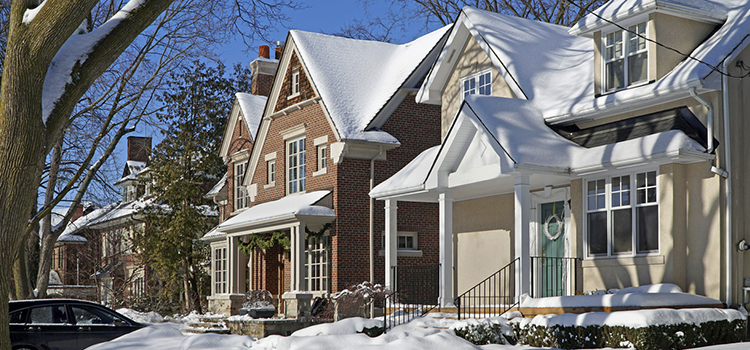If you’re hunting for a rental income property at an attractive price, you might be wondering when the best time of year to buy an investment property is.
Fortunately, technology is transforming the way people invest in real estate. Online marketplaces such as Roofstock are making it easier than ever to get great deals on investment properties — no matter where you live or what time of year it is.
However, if you decide to go the traditional route of searching for an investment property, you may find that the end of the year brings the best bargains.
Here are six reasons why November and December can be an attractive time to buy an investment property:
1. Fewer sellers are putting their homes on the market
Fall weather tends to put a chill on home buying. After all, how many sellers want to open their house to buyers who are trudging through the water puddles and brave slick walkways to view properties?
The answer: motivated sellers and savvy investors who know the majority of their competition is planning to stay put until the sun returns. Normally, existing home sales are relatively flat toward the end of the year.
However, REALTORS reported subdued market activity in October 2021 compared to one year ago and the prior month. That’s a potential indication that the recent hot market is cooling off a bit and creating opportunities for buyers in November and December.
The time of year isn’t the only thing thinning the number of listings on the market. “Typically, parents of school-age children don’t want to relocate in the middle of the school year,” points out Matt Mullin, Director of Broker Services for Roofstock.
Fewer buyers lowers your risk of competing against all-cash, over-asking price offers and increases your negotiating power with sellers.
This year, resolve to begin your investment property search while everyone else is still indoors binge watching “The Queen’s Gambit” on Netflix.
Tip: While sales at year-end are slow everywhere, Midwest markets such as Indianapolis see even fewer home sales in November and December than the rest of the country. Online marketplaces like Roofstock make it easy to take advantage of such regional differences no matter where you live.
>>Find Your Investment Property Here<<
2. Lower sale prices while they last
Housing experts have become more bullish on the housing market, and are now more optimistic about 2021 home price growth than they’ve been in more than three years.
The Zillow September 2021-September 2022 Home Value & Forecast expects home value growth to slow down between now and the end of the year, although sales activity will still remain strong. Home sales are expected to reach 6.04 million by the end of 2021, an increase of 7% compared to 2020.
Zillow predicts the near-term, 3-month forecast for home value growth to be slightly lower than 4.7%, driven in part to modest declines in home value growth over the summer. However, longer-term home values are forecast to increase 13.6% by September 2022. Rising home values over the next 12 months will be driven by a slowdown in inventory growth and an increase in for-purchase mortgage activity. As a result, longer-term home value appreciation should be greater than previously anticipated.
The continued upswing in home prices makes buying in sooner rather than later all the more attractive.
Although there may not be as many listings this time of year, many home buyers consider October to December the best time to buy a house because of price reductions. Sellers whose listings haven’t yet sold tend to be more motivated as the holidays near. - Houselogic
Recent data from the National Association of Realtors (NAR) shows that the median price of existing home sales historically declines during the last three months of the year. But once the new year arrives, prices begin to rise as sellers prepare for the spring selling season.
So is it really better to buy in November and December? Both sides have their defenders.
Pros of buying a house in November and December
- Slow selling months of November and December give buyers a big advantage
- Real estate agents, mortgage brokers, and home inspectors have more time on their hands, making your transaction smoother and faster
- Sellers may be under intense personal pressure from health, work, or marital issues that force them to sell at a bad time of year
- End-of-the-year tax deductions if you close on your home purchase before December 31st
Cons of buying a house in November and December
- Sellers may think a buyer is desperate to make a deal when they shop outside of the normal selling season
- Air conditioning and landscape watering systems are difficult to accurately check when temperatures begin to cool
- Fewer homes on the market mean your purchase options may be limited
- Waiting too late in the year to buy can actually take longer to close due to holiday vacations and earlier-than-expected winter weather
3. Time is on your side
When looking through listings, be sure to pay attention to the total number of days each home has been on the market, aka the “cumulative days on market.” If a property has been lingering on the market for several months, sellers may be more motivated to enter negotiations. This puts buyers in a stronger bargaining position.
For buyers who want to save money – and who doesn’t? – finding a house in the fall or winter may be the best time of year to get a lower sales price. That’s because sellers typically see fewer buyers toward the end of the year, and may be much more willing to make a deal.
Below: To compare seasonal trends for different metro areas across the U.S., check out the "Days on Market" data provided by Realtor.com. (This table is easier to navigate by hitting the "expand" icon in the bottom right corner.)
4. Motivated sellers
Realtors usually recommend sellers hold off on listing their properties until the spring and summer. Homeowners who choose to put their homes up for sale toward the end of the year are probably doing so because they need or want to sell now. Whether the pressure to move is due to a job relocation, financial reasons, or family issues, these sellers may be open to a lower offer and might close faster.
As this article from Quicken Loans points out, for more negotiating power, shop in the winter months. Why? Occasionally, realtors advise a subset of sellers to list their homes in the winter: those who haven’t recently remodeled their interiors. These homes might not have shiny new cabinets and trendy quartz countertops, but they just might have great bones and an appealing price tag.
5. You can view the house in a challenging climate
Early winter weather isn’t just rough on you. It’s hard on houses as well. Bare trees and brown lawns kill curb appeal. Cold air seeps in through drafty windows and under doors. Cranky furnaces never rev up to the right temperature. Ice dams accumulate on the roof.
Shopping for properties as fall turns into winter allows you to see houses under stress before you commit to taking on these challenges as a landlord. The air conditioner might get a pass, but you’ll be able to put the rest of the home through its paces.
6. Better mortgage rates
If you’re planning to finance your investment property, the end of the year is the ideal time to lock in the best loan interest rate and save money on interest in the long term. After hitting a 10-year high of 5.1% in late 2018, the benchmark 30-year fixed mortgage rate slid downward, and now rates are beginning to rise again.
According to Bankrate.com’s latest survey of the nation’s largest mortgage lenders, the benchmark 30-year fixed mortgage rate has been edging up , increasing 2 basis points over the past week, from 3.22% to 3.24%. The 15-year fixed-rate mortgage rate increased from 2.51% to 2.52% over the past week, while the 5/1 adjustable-rate mortgage interest rate fell from 3.32% to 3.29%.
Although the Federal Reserve’s taper of asset purchases is creating upward pressure, mortgage interest rates are unlikely to spike, according to the Mortgage Bankers Association Chief Economist Mike Fratantoni. However, mortgage rates are anticipated to keep rising over the next 12 months. As Fratantoni notes, “We expect that rates on 30-year mortgages will increase from 3.2% today to about 4% by the end of 2022.
There’s an added bonus for earlier buyers: Fewer customers vying for home loans toward the end of the year could translate into better financing terms for you.
It’s also worth noting that rising mortgage rates contain a silver lining for those who already own investment properties (or purchase one soon). With home prices continuing to rise, higher mortgage rates of just a few hundred basis points could drive even more people to rent where they live. According to a Realtor.com analysis, rising home prices, a lack of starter-homes available for sale, and competition are pushing buyers out of the market, even at today’s low rates.
Final Thoughts
While November and December may bring less competition and potentially better deals, today’s rental property investors can access affordable, cash-flowing rental properties—no matter the season.
At Roofstock, we offer a wide selection of vetted investment properties at attractive entry points year-round. Rental property investors can purchase tenant-occupied homes in a variety of strong markets across the country and start collecting rental income as soon as they close.
So even if you get swept up in new year to-do lists (yes, we hear that gym membership calling too) and don’t get around to real estate investing this winter, don’t let FOMO sink in: At Roofstock, we make any time of year a great time to buy rental property.









